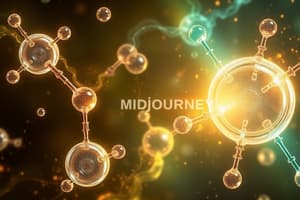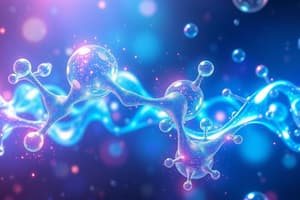Podcast
Questions and Answers
What type of monomers make up nucleic acids?
What type of monomers make up nucleic acids?
- Amino acids
- Nucleotides (correct)
- Fatty acids
- Carbohydrates
Which statement regarding protein structure is true?
Which statement regarding protein structure is true?
- Proteins always have a linear shape.
- The shape of a protein determines its function. (correct)
- All proteins are identical in structure.
- Protein structure is unchanged by pH levels.
What replaces thymine in RNA?
What replaces thymine in RNA?
- Guanine
- Uracil (correct)
- Adenine
- Cytosine
Which bond is formed between amino acids in proteins?
Which bond is formed between amino acids in proteins?
Which of the following nitrogenous bases is found in DNA but not in RNA?
Which of the following nitrogenous bases is found in DNA but not in RNA?
Which of the following accurately describes a characteristic of bases?
Which of the following accurately describes a characteristic of bases?
What is formed during a neutralization reaction between an acidic solution and a basic solution?
What is formed during a neutralization reaction between an acidic solution and a basic solution?
What defines a buffer in a solution?
What defines a buffer in a solution?
Which of the following statements about organic compounds is true?
Which of the following statements about organic compounds is true?
Which of the following is NOT a characteristic of monosaccharides?
Which of the following is NOT a characteristic of monosaccharides?
What is the primary use of glycogen in animals?
What is the primary use of glycogen in animals?
Which of the following accurately describes lipids?
Which of the following accurately describes lipids?
Which type of carbohydrate is formed when two monosaccharides join together?
Which type of carbohydrate is formed when two monosaccharides join together?
What particle in an atom determines its atomic number?
What particle in an atom determines its atomic number?
Which type of chemical bond is formed by the sharing of electrons?
Which type of chemical bond is formed by the sharing of electrons?
What is the net charge of an atom with 4 protons, 4 neutrons, and 5 electrons?
What is the net charge of an atom with 4 protons, 4 neutrons, and 5 electrons?
Which of the following is characteristic of hydrogen bonds?
Which of the following is characteristic of hydrogen bonds?
In the context of chemical reactions, what occurs when molecules interact?
In the context of chemical reactions, what occurs when molecules interact?
Which property of water allows it to support small organisms on its surface?
Which property of water allows it to support small organisms on its surface?
What is produced when an acid donates a hydrogen ion?
What is produced when an acid donates a hydrogen ion?
Which of the following statements is true regarding ionic bonds?
Which of the following statements is true regarding ionic bonds?
What aspect of water makes it known as the 'Elixir of life'?
What aspect of water makes it known as the 'Elixir of life'?
Which particle generally has no charge and is found in the nucleus of an atom?
Which particle generally has no charge and is found in the nucleus of an atom?
Flashcards are hidden until you start studying
Study Notes
Matter - Atoms, Elements, Molecules
- Chemistry is the study of matter
- Elements are substances that cannot be broken down into other substances
- An atom is the smallest unit of an element that retains its characteristics
- The nucleus of an atom contains protons (+1) and neutrons (no charge)
- The number of protons in an atom determines its atomic number
- Electrons (-1) surround the nucleus
Chemical Bonds
- Covalent bonds are the strongest chemical bonds and form molecules
- Two or more atoms held together by covalently shared electrons form a molecule
- A compound or molecular element can be formed by covalently shared electrons
- Ionic bonds form when an atom exchanges an electron with another atom.
- Hydrogen bonds are the weakest bonds
- They temporarily help separate molecules together
- They are responsible for holding complementary DNA strands together
Chemical Reactions
- Chemical reactions occur when molecules interact with each other to form one or more molecules of a different type
Thermodynamics of Chemical Reactions
- Chemical reactions can be either endothermic or exothermic
- Endothermic reactions require heat input
- Exothermic reactions release heat
Properties of Water
- Water has a high specific heat which means it can resist temperature changes
- It also has a high surface tension which allows small particles and organisms to rest on its surface
- Water is a polar molecule and can dissolve many types of organic and inorganic substances
Acids, Bases, and Buffers
- When a chemical is dissolved in water it may behave as an acid, a base, or a buffer
- Acids donate protons (H+ ions) and their conjugate base is what remains after it donates a hydrogen ion
- Bases accept protons (H+ ions) or donate hydroxide ions (OH-) and their conjugate acid forms when the base gains a hydrogen ion
- A neutralization reaction of acidic and basic solutions will result in water and salt
- A buffer is an aqueous combination of a weak acid and its conjugate base, or a weak base and its conjugate acid.
Chemical Structure of Organic Compounds
- Organic compounds contain carbon
- Organic molecules contain hydrogen, oxygen, nitrogen, sulfur, phosphorus and some metal ions
- Monomers act as the basic building blocks of biomolecules
- Polymers are larger molecules formed from repeating units of monomers
- Monosaccharides are simple sugars made of 3 to 7 carbon atoms
- Glucose (C₆H₁₂O₆) is a key sugar used for energy and is a monosaccharide
- Disaccharides are a type of carbohydrate where two monosaccharides join together
- Sucrose (table sugar) is a disaccharide composed of glucose and fructose
- Polysaccharides are long chains of monosaccharides
- Cellulose is a structural component in plant cell walls
- Glycogen is used by animals for short-term energy storage
- Isomers are molecules, such as glucose and fructose, that share the same molecular formula but differ in the arrangement of their atoms.
- Carbohydrates are organic compounds made of carbon, hydrogen and oxygen
- Lipids are organic compounds made of carbon, hydrogen, and oxygen
- Lipids are hydrophobic and do not dissolve in water
- Lipids perform various functions in cells such as acting as a structural component or providing energy storage
- Proteins are large unbranched polymers made of amino acid monomers
- Amino acids are cyclic molecules containing carbon, hydrogen, oxygen, nitrogen, and sometimes sulfur or phosphorus
- Amino acids form polypeptides through peptide bonds
- Proteins shape is determined by its function and is found in 3D structures
- Enzymes are proteins that catalyze reactions
- Nucleic acids are made of nucleotide monomers which contain a 5-carbon sugar, phosphate group, and nitrogenous base
- The two types of nucleic acids are DNA (deoxyribonucleic acid) and RNA (ribonucleic acid)
- Nitrogenous bases include adenine (A), cytosine (C), guanine (G), and thymine (T) for DNA and uracil (U) replaces thymine in RNA
- Nucleotides pair to form the double-helix structure in DNA
DNA vs. RNA
- DNA is double stranded
- RNA is single stranded
- DNA contains deoxyribose sugar
- RNA contains ribose sugar
- DNA has thymine as a nitrogenous base
- RNA has uracil as a nitrogenous base
Complementarity
- In DNA, adenine pairs with thymine
- In DNA, cytosine pairs with guanine
- In RNA, adenine pairs with uracil
- In RNA, cytosine pairs with guanine
Studying That Suits You
Use AI to generate personalized quizzes and flashcards to suit your learning preferences.




